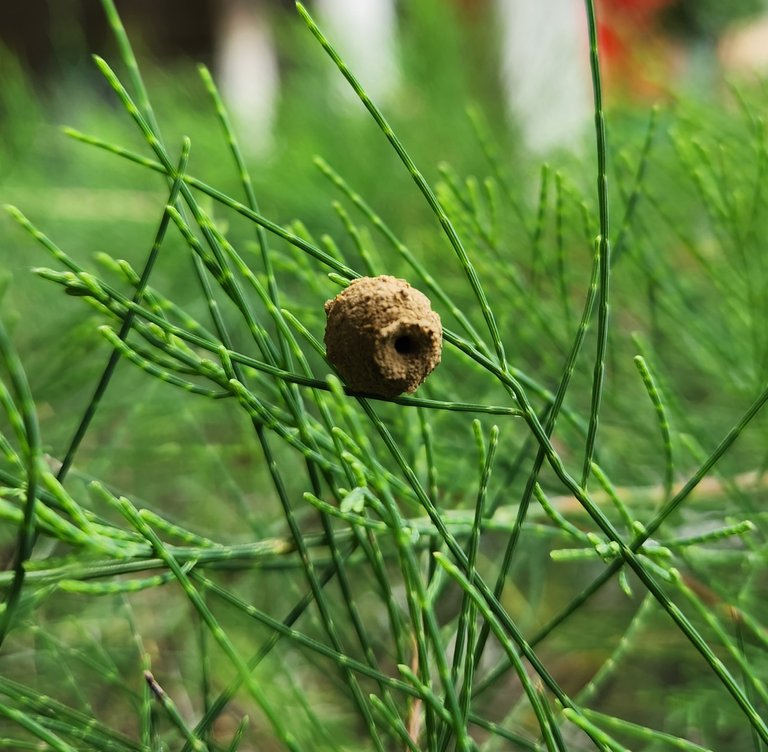Hi Hive Lovers

There are unique things that you can find around your garden, and you will be amazed if you are willing to pay attention to the little things that you rarely find there.
I wasn't sure what I had discovered until I actually looked very closely, to be sure. They are too small, so I got really close and even used the macro mode on my #SamsungS22 phone camera to get the best pictures of them.
The round nest
The round nest seems to be a small wasp's nest whose owner I don't know for sure. I had been there for a while, but not a single animal had come close enough to say that they were the ones who built the round nest.
The round nest is made completely from earth, and just by attaching a little of the back part to a leaf—it's not really a leaf; I'll just call it a needle leaf.
I was able to circle my pine tree to capture photos of the round nest from various angles. You can also notice their appearance from my photos below:










I've also put a small blue pen in there in the hope that you'll get an idea of the comparative size of that amazing round nest.




I assume that the spherical nest has been painstakingly built, and with the complex architectural capabilities of the animal world, it's easy for them, but it's a complicated thing for us. You can see how the entrance to the nest was built with additional landing areas around it, right?
The hexagonal nest
The second nest is an insect nest with a very unique shape. It seems that this hexagonal nest is still under construction and is almost finished. They all have five rooms that have the same shape, and it seems like that's all there is to it because it doesn't look like there will be any additional rooms.






Looking at the construction of this nest, you will immediately remember the beehive, but the number of rooms in the beehive is much greater because bees live in large colonies. This second nest appears to be owned by a small, simple family whose members do not number as many as a swarm of honey bees. Wasps don't have colonies; is that true?
The raw material for building this second nest is not at all from earth, like the first round nest. It seems that this second nest has been built from dark brown paper, but you know that it is not actually made of paper but rather cellulose fiber mixed with wasp saliva, which is very different from honey bee nests, which are made from wax.
I had been very careful approaching the two tiny nests. I'm sure I was an uninvited guest for them and would definitely be considered a threat to them. I am sure that the inhabitants of these two nests are not good nest masters; they are known to be very aggressive. So, I didn't want to linger around there too long, lest I get an unexpected attack.
Looking back at their appearance from the photos I have captured, it is much easier and clearer to pay close attention to their appearance and shape than to see their little nest directly.
Making them into photos is also much safer, and you can spend time looking at them. Advances in photographic technology have given everyone inner satisfaction that the small and unique things around us can be immediately captured with just a cellphone camera that everyone has and bring out their unique and amazing appearances, making it faster, safer, and closer to us.
The two photos below are bonuses in the form of two juvenile grasshoppers that have become permanent residents of my pine tree. They happily camouflaged before becoming adult grasshoppers, and they were there every time I approached the tree.



It's a beautiful environment to share with them, and it will always be amazing for us to enjoy it.

Beautiful post, the last photo of the grasshopper was my favorite, it looks stunning.
After seeing those nests if your me thinking, maybe humans a really long long time ago were inspired and somehow try to copy this model of houses
Nice to meet you, and thanks for stopping by, @ronrronea.
What is it that humans don't learn and take examples from nature?
I agree with you and say that if you look at traditional houses, you will find that the houses of some animals are almost the same as human houses.
Even a dragonfly has been an inspiration for humans to make a helicopter model, right?
Makes totally sense, now I won't be able to stop seeing dragonflies instead of helicopters haha
The movement system for dragonflies is the same as that for helicopters (which comes first?).
but dragonflies don't have bombs to throw, Ha.. Ha.. Ha..
Reviewed and Approved for an Ecency boost. Keep up the good work.
Thanks a lot, @itwithsm.
Have a great day.
Yay! 🤗
Your content has been boosted with Ecency Points, by @justbabybee.
Use Ecency daily to boost your growth on platform!
Support Ecency
Vote for new Proposal
Delegate HP and earn more